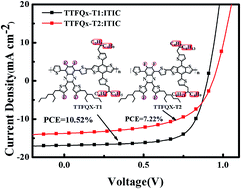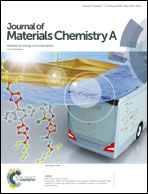Optimizing the conjugated side chains of quinoxaline based polymers for nonfullerene solar cells with 10.5% efficiency†
Abstract
Quinoxaline (Qx) has an easily modifiable structure, which allows for fine-tuning its properties through optimizing the length of side chains and the kinds of aromatic rings in conjugated side chains. Qx based polymer PBDTT-ffQx with alkoxy substituted fluorobenzene side chains shows a power conversion efficiency (PCE) of 8.47% in nonfullerene solar cells. In this work, we change the alkoxy substituted fluorobenzene side chains to alkyl substituted fluorothiophene in the Qx unit and employ the benzodithiophene (BDT) unit with different lengths of alkyl thiophene side chains to obtain two new Qx based polymers, named TTFQx-T1 and TTFQx-T2, respectively. The TTFQx-T1:ITIC blend film has clear nanoscale phase separation and a suitable domain size, and the device with the TTFQx-T1:ITIC blend film shows lower geminate recombination and higher charge mobility than those with TTFQx-T2:ITIC. Therefore, the TTFQx-T1:ITIC based device exhibits a higher PCE of 10.52% than that based on the TTFQx-T2:ITIC blend with a moderate PCE of 7.22%. The inverted devices from TTFQx-T1:ITIC blends with a larger active area of 16 mm2 than the conventional device (4.5 mm2) show a good PCE of 9.21%. The results highlight that the alkyl lengths and the kinds of aromatic rings in side chains are significant for the development of high performance photovoltaic polymers. Optimizing the conjugated side chains of Qx based polymers is an efficient way to improve photovoltaic properties, and Qx based polymers are potential candidates for fabricating highly efficient polymer solar cells.



 Please wait while we load your content...
Please wait while we load your content...